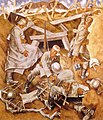Category:Rathaus Schöneberg murals by Franz Eichhorst
Jump to navigation
Jump to search
Deutsch: Freskenzyklus im Rathaus Berlin-Schöneberg oder Freskengemälde im Rathaus Schöneberg.
- Fresken über drei Wände. Das Werk überstand die Bombardierungen des Gebäudes gegen Ende des Zweiten Weltkrieges. Die Wandbilder wurden aber im Mai 1945 als unerwünschte NS-Propaganda übermalt.
- Künstler: Franz Eichhorst
- Titel: Vom Anfang des Weltkrieges bis zur nationalen Erhebung: Gesicht des jungen Deutschland
- Jahr: ca. 1935–38
- Adresse: Rathaus Schöneberg (Bürgersaal), Hauptstrasse 135, Berlin
- Zyklus aus dem Jahr 1938 von Franz Eichhorst im Rathaus von Berlin-Schöneberg über die dt. Gesch. vom Ersten Weltkrieg bis zur Konstituierung des Dritten Reichs' (Klaus Wolbert, Programmatische Mal., in: Georg Bussmann [Red.], K. im 3. Reich. Dokumente der Unterwerfung, FfM. 41980, S. 284–292; das F. wurde im Mai 1945 übermalt: Wilfried Welz und Cornelius C. Goeters, Rathaus Schöneberg ..., Bln. 21995, S. 60).
- 11. Januar 1939: Heute wird der Bürgersaal des Schöneberger Rathauses seiner Bestimmung übergeben. Er wurde von dem bekannten Charlottenburger Maler Prof. Franz Eichhorst mit Fresken ausgeschmückt, die das Schicksal Deutschlands in dem letzten Vierteljahrhundert zeigen.
English: A cycle of frescoes by Franz Eichhorst (German war painter, 1885 – 1948) over three walls in the Bürgersaal of the Rathaus Schöneberg, the city hall for the borough of Tempelhof-Schöneberg in Berlin, Germany ca. 1935 – 1938. The work survived the bombing of the building towards the end of World War II, but the murals were repainted as unwanted Nazi propaganda in May 1945.
Artist: Franz Eichhorst
Title: Vom Anfang des Weltkrieges bis zur nationalen Erhebung ('From the beginning of the world war to the national upliftment')
Year: circa 1935–38
Address: Rathaus Schöneberg, Hauptstrasse 135, Berlin
- Giles Macdonogh, standpointmag.co.uk 2019:
- Eichhorst was an opportunist whose oeuvre is divided between war and peasant life. His lost murals in Schöneberg Town Hall in Berlin were strangely reminiscent of Stanley Spencer’s work at Burghclere, expressionistic with a hard edge like Dix or Beckmann. His experience as a soldier in the Great War endeared him to the Nazis. Like many Third Reich painters, he did a stint as a war artist. (...) Murals were naturally painted over. The most obvious example is the Sistine Chapel of the Third Reich: Eichhorst’s paintings in Schöneberg.
Media in category "Rathaus Schöneberg murals by Franz Eichhorst"
The following 18 files are in this category, out of 18 total.










